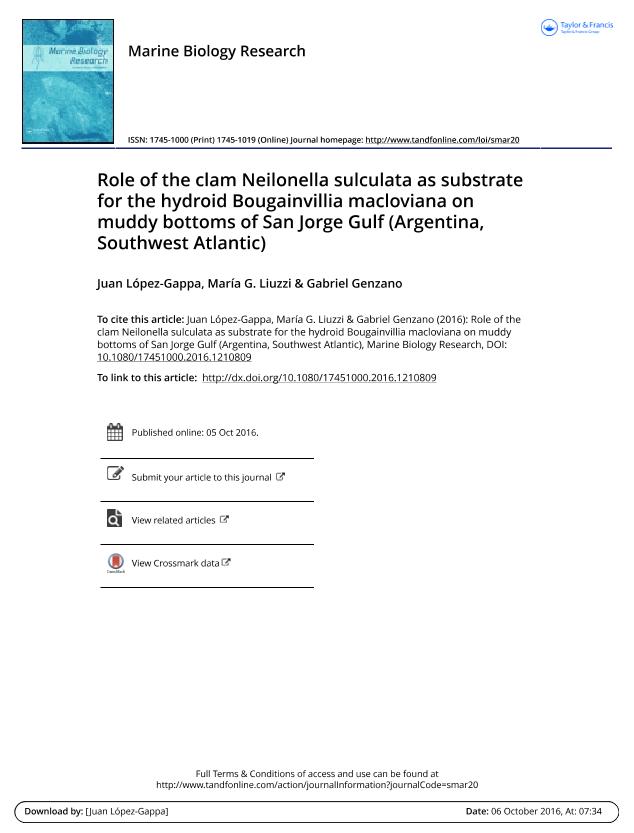Artículo
Role of the clam Neilonella sulculata as substrate for the hydroid Bougainvillia macloviana on muddy bottoms of San Jorge Gulf (Argentina, Southwest Atlantic)
Fecha de publicación:
10/2016
Editorial:
Taylor & Francis As
Revista:
Marine Biology Research
ISSN:
1745-1000
Idioma:
Inglés
Tipo de recurso:
Artículo publicado
Clasificación temática:
Resumen
The clam Neilonella sulculata is the dominant bivalve on muddy bottoms along the Argentine continental shelf (Southwest Atlantic). The medusa stage of the hydroid Bougainvillia macloviana is one of the most abundant species in the gelatinous zooplankton of the Magellan region. Two benthic surveys carried out in 2007 and 2009 in San Jorge Gulf gave us the opportunity to analyse (1) the interaction between N. sulculata and its epibiont, B. macloviana, and (2) the role of the clam as hard substrate in a depositional area characterized by silt/clay sediments. Bougainvillia macloviana has a high prevalence on the posterior region of live clams. The presence of gonophores shows that these small colonies are able to reproduce there. Hydroid colonies are very rare on dead valves of N. sulculata and also on almost all other live bivalve species in the study area. Specimens of N. sulculata with hydroids were slightly but significantly larger than those without them, both in 2007 and 2009. The high prevalence of B. macloviana on live individuals of N. sulculata and its almost total absence on other clam species suggest that this association may be critical at least for the epibiont and not the result of chance alone.
Palabras clave:
Benthic Infauna
,
Bivalve
,
Epibiosis
,
Hard Substrate Islands
,
Hydrozoa
Archivos asociados
Licencia
Identificadores
Colecciones
Articulos(IIMYC)
Articulos de INSTITUTO DE INVESTIGACIONES MARINAS Y COSTERAS
Articulos de INSTITUTO DE INVESTIGACIONES MARINAS Y COSTERAS
Articulos(MACNBR)
Articulos de MUSEO ARG.DE CS.NAT "BERNARDINO RIVADAVIA"
Articulos de MUSEO ARG.DE CS.NAT "BERNARDINO RIVADAVIA"
Citación
López Gappa, Juan José; Liuzzi, Maria Gabriela; Genzano, Gabriel Nestor; Role of the clam Neilonella sulculata as substrate for the hydroid Bougainvillia macloviana on muddy bottoms of San Jorge Gulf (Argentina, Southwest Atlantic); Taylor & Francis As; Marine Biology Research; 12; 8; 10-2016; 888-893
Compartir
Altmétricas




